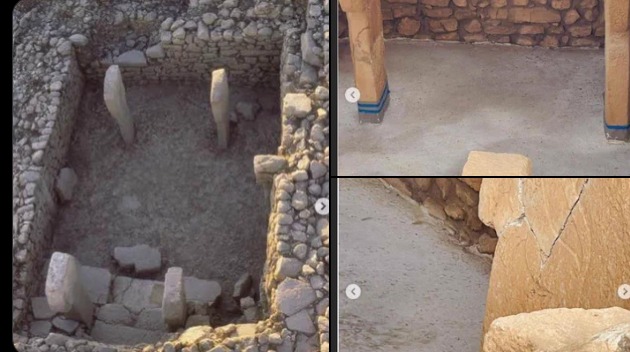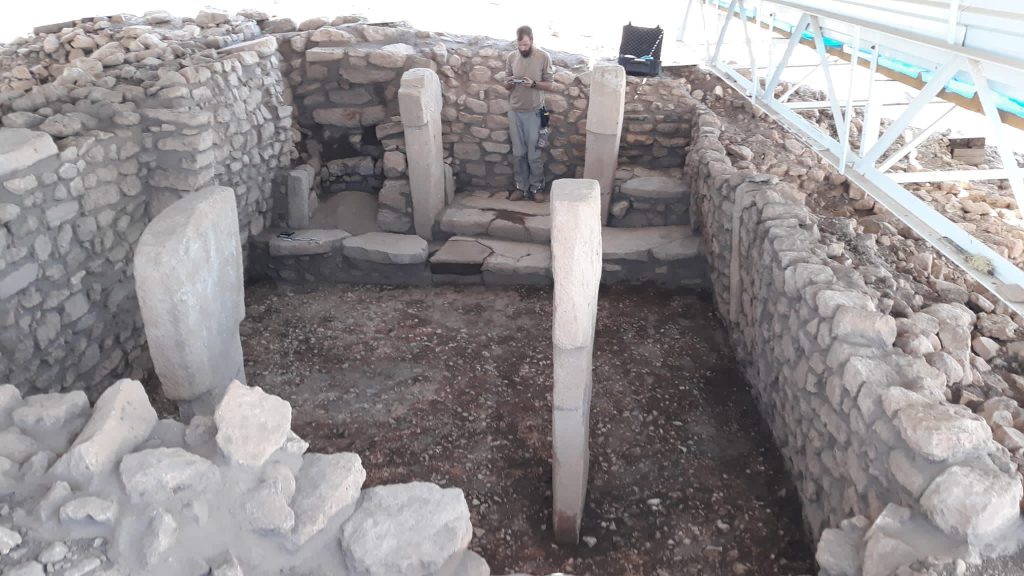
Is concrete being poured at Göbeklitepe that zero point of human history?
The news that concrete has been poured in a certain area of Göbeklitepe, which is considered the zero point of human history, located in the Şanlıurfa province in the Southeastern Anatolia Region of Türkiye, has caused astonishment.
The claim that concrete was poured at Göbeklitepe came from Çiğdem Köksal-Schmidt, the wife of Klaus Schmidt, who discovered Göbeklitepe and initiated the first excavation work.
Schmidt made the following statement on social media: “I will share this as a observation, and let anyone do what they want with the rest, because I will have to deal with the lynching I will face later. Within the Göbeklitepe excavation team, there is an area we call the ‘Lion Building.’ It is located near the wishing tree, rectangular in plan, and is known mainly for the female figure made with the engraving technique on a stone bench, which belongs to the last phase of Göbekli Tepe before it was abandoned. This structure was made with a kind of plaster created by crushing limestone and adding heat and liquid components to it. There is even a Neolithic quarry and workshop nearby where such mixtures were prepared.”
“Two days ago, a guest of mine took photos of this structure. It seems that restoration work is being done here. We can see that the wall plaster is brand new, but our eyes can be stuck on the original base of the structure, mine certainly are. Did it really need to be completely covered with a foreign modern material? I don’t know if there are similar examples in the restoration of architectural works dating back 12,000 to 10,000 years, but I don’t understand why the floor of a structure from the Neolithic period is covered with materials like white cement, sand, and gypsum. The purpose must be preservation, but if it was going to be renewed, why not fill the entire structure with sifted sterile soil, bury it, and then reconstruct an exact replica on top of it? This would have been the best way to preserve it.”
In the studies conducted under the guidance of science, original mortar suitable for the original wall and floor texture has been used, not concrete.
The General Directorate of Cultural Heritage and Museums responded to the claims made by Çiğdem Köksal-Schmidt on social media, which quickly spread and generated intense reactions, through social media platform X.
The Directorate General of Cultural Heritage and Museums issued the following statement: “Following the passing of the then excavation director Klaus Schmidt, there was a temporary hiatus in the Göbeklitepe excavations, and excavation work was resumed in 2019. It was decided that the team, consisting of members from Istanbul University and the German Archaeological Institute, would conduct their work with a priority on preserving and conserving the remains. Especially, the earthquake risk in the region highlighted the urgency of these measures. As stated in the 2023 working program submitted to the Ministry of Culture and Tourism, conservation work has commenced on the buildings known as the ‘Lion Building’ and ‘Structure F.'”

“The structures uncovered at Göbeklitepe were constructed using earth mortar and their surfaces were covered with earth plaster. These earth plasters have been preserved in very limited areas to this day. In completed excavated structures, the natural deterioration of the wall joints occurs, leading to the risk of collapse. Indeed, this natural wear and tear occur more rapidly until they are protected by a roof. In the application performed on these structures, the joints were superficially filled with a mortar made by sieving the soil excavated from Göbeklitepe, mixed with water, goat hair, and flax. The wall structure itself has been preserved. Adding plant materials to the filling mortar in such applications can lead to the growth of plants and damage to the stones, which is why it is not preferred. In the structure floors, it is understood that an impermeable surface was obtained using a mortar called ‘terrazzo,’ which is produced by burning limestone.”
Göbeklitepe’deki koruma çalışmaları sırasında beton kullanıldığı iddialarına dair kazı başkanlığımızca detaylı açıklamalar yapılmıştır.
— Kültür Varlıkları ve Müzeler Genel Müdürlüğü (@kvmgm) September 13, 2023
Bilimin ışığında yürütülen çalışmalarda beton değil orijinal duvar ve zemin dokusuna uygun harç kullanılmıştır. Kamuoyunun bilgisine sunulur. https://t.co/0BLw2ay1OI
“The floors of the structures undergoing conservation at Göbeklitepe are largely damaged. The quality of the mortar used, its condition reaching our time, and the natural deterioration that occurred over time after the excavation are contributing factors. In the preservation of such floors, protective materials are applied or the approach of covering is taken, depending on the current state of the floor. In the application at Göbeklitepe, considering the current condition of the floors, they were cleaned and then covered with a protective layer that prevents vegetation. On top of this covering, a natural mortar with a thickness of approximately 2.5 cm, made of recycled limestone with screened excavation soil and limestone gravel, was applied. White cement or similar materials are not used in this application.”
“Furthermore, the fallen standing stones in these structures have been repositioned to recreate the original integrity of the structure, in addition to the conservation and organization of the site. In Göbeklitepe, which is listed on the UNESCO World Heritage List, great care is taken to preserve the remains in their original state in situ, and the importance of establishing a meaningful interaction with visitors to the site is emphasized.”
You may also like
- A 1700-year-old statue of Pan unearthed during the excavations at Polyeuktos in İstanbul
- The granary was found in the ancient city of Sebaste, founded by the first Roman emperor Augustus
- Donalar Kale Kapı Rock Tomb or Donalar Rock Tomb
- Theater emerges as works continue in ancient city of Perinthos
- Urartian King Argishti’s bronze shield revealed the name of an unknown country
- The religious center of Lycia, the ancient city of Letoon
- Who were the Luwians?
- A new study brings a fresh perspective on the Anatolian origin of the Indo-European languages
- Perhaps the oldest thermal treatment center in the world, which has been in continuous use for 2000 years -Basilica Therma Roman Bath or King’s Daughter-
- The largest synagogue of the ancient world, located in the ancient city of Sardis, is being restored











Leave a Reply